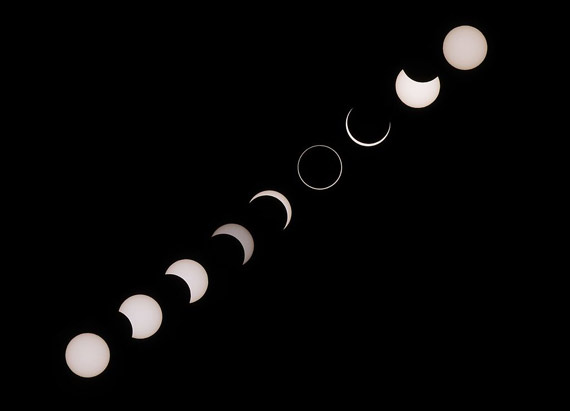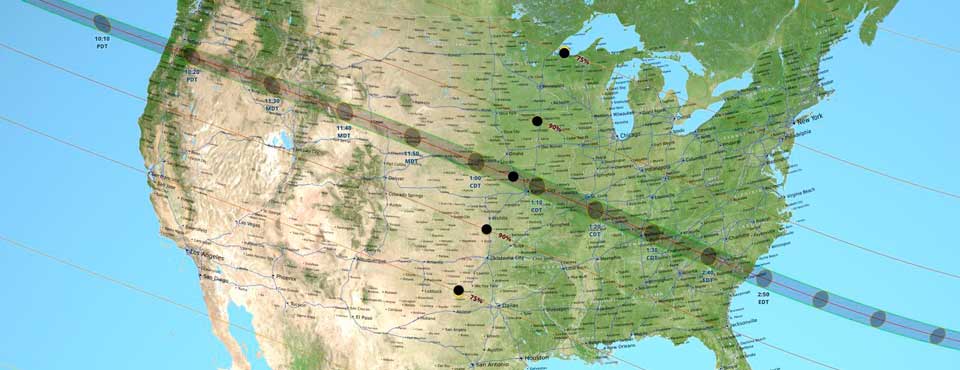Total eclipses of the Sun are a unique opportunity to study the star, and also our planet, under very specific conditions. Throughout history these events have led to important scientific breakthroughs. Let’s review some of the discoveries that eclipses have given us.
The first recorded solar eclipses
There are historical references to solar eclipses from more than 2,000 years before our era in China, Babylon and Egypt. An oft-quoted legend, of questionable veracity, tells of two Chinese astronomers named Hi and Ho who were reportedly executed by the emperor after getting drunk and failing to predict an eclipse, which may have taken place in 2136 or perhaps 2159 BC.
The first solar eclipse for which we have written records occurred in the port city of Ugarit, today’s Ras Shamra in Syria, a total eclipse that darkened the daytime sky for two minutes and seven seconds. We know this thanks to modern calculations and because historians of the time recorded this data, describing that “the Sun was hidden in shame,” on a clay tablet discovered in 1948 during an archaeological excavation. Although early calculations dated this eclipse to 3 May 1375 BC, a later study corrected the date to 5 March 1223 BC.
Vídeo: What creates a total solar eclipse? Credit: TED-Ed
Subsequent records of other solar eclipses appear, some of which were of historical significance. The so-called Mursili’s eclipse occurred, according to ancient texts, in the tenth year of the reign of Mursili II in the Hittite empire, which has helped historians to trace the chronologies of the Near East. The problem is that, given the frequency of eclipses, there are discrepancies as to whether this particular event corresponds to the annular eclipse of 13 March 1335 BC, or the total eclipse of 24 June 1312 BC, or two other possible dates. The chronology provided by the Assyrian eclipse, assigned to 15 June 763 BC, seems more precise. The eclipse of Thales, so called because according to Herodotus it was predicted by the Greek philosopher Thales of Miletus and took place on 28 May 585 BC, interrupted a battle between the Medes and the Lydians, who agreed to a truce after interpreting the event as an omen.
Although the eclipse of Thales is sometimes cited as the first eclipse predicted in advance, some scholars question the veracity of the prediction. The Babylonians are believed to have been able to predict the dates of eclipses fairly well, although they attributed a divine origin to them. In ancient China, it was a dragon that devoured the Sun, and people would head outside banging pots to scare away the beast. Both the Babylonians and later the ancient Greeks used the so-called Saros cycle to predict eclipses. If the Moon orbited in the same plane as the Earth orbits the Sun, we would see a total eclipse every month. However, the Moon is tilted with respect to that plane, so eclipses are rare phenomena that repeat in cycles of 18 years, 11 days and 8 hours, which is called a Saros cycle. Each cycle contains 84 eclipses: 42 solar eclipses (total, annular and partial) and 42 lunar eclipses. Data on historical eclipses have helped scientists to understand long-term variations in the motions of the Earth-Moon system, while today’s more precise calculations have also made it possible to date some of these ancient events.
Calculating the distance from the Earth to the Moon
The calculations of Aristarchus of Samos, first, and those of Hipparchus of Nicaea, later, based on observations during eclipses, made it possible to estimate the distance from the Earth to the Moon for the first time in 150 BC.
The ancient Greeks deduced that the Moon was closer to the Earth than the Sun because it passed in front of it whenever there was an eclipse. They also managed to calculate the shape and dimensions of the Earth with a precision that today we know was quite accurate. From there, Hipparchus, using a method devised by Aristarchus some 120 years earlier, calculated that the Moon was 379,000 kilometres away, a very good estimate since the actual average distance from the Moon to the Earth according to current calculations is 384,000 kilometres.
The science of solar eclipses
Although the ancient Chinese, Greeks and Byzantines attempted to describe and explain solar eclipses and their characteristics, it was not until the early 17th century that the German astronomer Johannes Kepler came up with the quantitative and geometrical structure of the Solar System. Thanks to Kepler’s famous three laws, which define the motions of the planets, a more detailed explanation of eclipses could be given.

Four hundred times closer to the Earth than the Sun, the Moon is also four hundred times smaller than our star, an astronomical coincidence that makes the apparent size of the Sun and Moon as seen from Earth similar, allowing total solar eclipses to occur, a phenomenon that occurs when the centres of the Sun, the Moon and the Earth align. When this happens, the ambient light dims in the middle of the day, the temperature drops and one of nature’s most striking spectacles takes place. Minutes before that moment, the Sun begins to disappear little by little, obscured by the passage of our satellite.
More than a century after Kepler’s findings, the English astronomer Edmund Halley (known for the comet that bears his name) accurately predicted the time and path of the solar eclipse of 3 May 1715. His calculations only deviated by 4 minutes and 30 kilometres from the eclipse as it actually occurred.
The eclipse that proved Einstein’s Theory of Relativity
Perhaps the most famous eclipse of all time is the one that took place on 29 May 1919, because it confirmed the general theory of relativity of the German physicist Albert Einstein. According to this theory, light rays passing close to the Sun must be deflected slightly, because the Sun’s gravitational field makes the light bend. If so, this effect could only be observed experimentally during eclipses, because otherwise the brightness of the Sun would make it impossible for us to see the affected stars.
During the eclipse of 1919, the actual and apparent positions of some thirteen stars in the constellation Taurus were compared. The conclusion was conclusive: the analysis of the measurements obtained from the light rays confirmed the deflection of the light due to the influence of the solar gravitational field, as predicted by Einstein’s theory. One of the most important theoretical predictions ever made in the history of science was verified, and only four years after it had been formulated.
What eclipses have taught us
During the total solar eclipse of 1836, British astronomer Francis Baily described a string of bright points of light appearing around the Moon in the moments before and after the maximum of the eclipse. These so-called Baily’s beads are produced by sunlight shining through the spaces between the lunar mountains. By timing and observing the moments of contact of the first and last beads, the profile of the Moon can be reconstructed with precision. The moment when only one bead is visible is known as the diamond ring, one of the most fascinating features of an eclipse.
Another solar eclipse is also responsible for the discovery of the chemical element helium. The first evidence of the second most abundant element in the universe was discovered by the French astronomer Jules Janssen, when he observed the solar corona during the total eclipse of 16 August 1868.
A total solar eclipse occurred on 21 August 2017 that received great media coverage because its path of totality crossed the entire US landmass from the west coast to the east coast, something that had not happened since 1918. This made it likely one of the most observed and studied eclipses in history, not only from Earth, but also from aircraft, high-altitude balloons, satellites and the International Space Station.
As a result, the eclipse facilitated a great deal of scientific research. NASA funded 11 studies, six of which focused on the solar corona, the outermost part of the Sun’s atmosphere which, paradoxically, is much hotter than the surface of the star. Among these projects, a team at NASA’s Goddard Center tested a new camera capable of simultaneously capturing multiple wavelengths of polarised light from the corona, without the need to change filters during the process, something which space probes studying the Sun currently have to do. The test was used to adapt the instrument for a balloon-borne experiment in 2019, and in the future it is expected to be applied to space missions as well.

The solar corona was also the subject of observations from two high-altitude NASA jets that followed the eclipse along its path, and whose data are being analysed to provide new findings on solar storms and the dynamics of the solar atmosphere. The concurrence of a coronal mass ejection during the eclipse has also made it possible to study how these phenomena influence changes in the temperature of the corona. The data are also feeding into studies of changes in the shape of the Sun’s magnetic field, which helps scientists to understand its cycles of activity that affect life on Earth.
Furthermore, scientific observations taken during the eclipse are also extremely useful for researchers studying the Earth’s atmosphere, as an eclipse is an abrupt break in the day-night cycle that alters the behaviour of the ionosphere, the electrically charged layer whose changes can affect communications and navigation. Thanks to the 2017 eclipse, scientists have been able to observe changes in the ionosphere up to 1,000 kilometres away from the path of totality, due to waves similar to those produced by a boat on the water. The data reveal that wind speed and direction also affect the changes in the ionosphere caused by the eclipse.
Finally, the study of climate is another field that has benefited from the 2017 eclipse. By measuring the reduction in light due to the phenomenon, scientists improve their models of how clouds affect the solar radiation absorbed and reflected by the Earth, which influences the climate and its changes.
When will there be an eclipse?
Calculations of celestial movements allow us not only to predict, but even to simulate solar eclipses in advance with an incredible level of detail, and this information can be found on the Internet. The website timeanddate.com offers not only a list of upcoming eclipses, but also conveniently draws their paths on a map of the world so that we can check if one is going to be observed in our region. By accessing each of them we can consult all the details and even see a simulation of how it will appear in our sky.
Comments on this publication